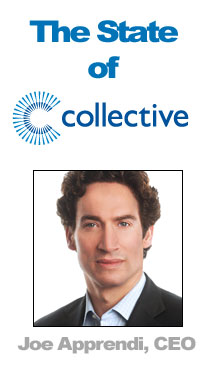 Joe Apprendi is CEO of Collective, an online advertising technology and services company.
Joe Apprendi is CEO of Collective, an online advertising technology and services company.
As part of its “State of…” series of articles with industry executives, AdExchanger.com sat down with Apprendi to discuss his company, his views on the space, and the state of Collective today.
Click below or scroll down for more:
- On Integrating The Acquisitions
- Getting Brand Marketer Buy-In
- Facebook And The Platform
- Biggest Challenges Ahead
- International Expansion and Media Buyers
- The Competitive Set
AdExchanger.com: Can you talk a bit about how the acquisitions of Web TV Enterprise, Tumri, Oggifinogi have evolved within Collective in the past year?
JA: First and foremost, let me say that Collective has been on a mission since day one: how do we build demand among brand advertisers versus what everybody else has done successfully? – which is monetizing the direct marketing stack. We think that has been the first evolution of display advertising, which includes a lot more now than just a straight, banner ad format. We’ve been trying to figure out how Collective can be the audience platform for brand advertisers and brand publishers. Everything we do is illustrated for that vision. It’s different than what the DSPs, trading desks and legacy ad networks are doing. It is more emblematic of what brand advertisers have been searching for in all media but maybe with the measurability they couldn’t obtain in other forms.
If you look back at 2011, we invested in two buckets. First, we entered the U.K. in late 2010. We wanted a level of critical presence so we acquired a company –but not a performance ad network. We acquired the leader in online video, of which 70 percent of that demand was from broadcast video decision makers versus digital decision makers, formerly Web TV. That was a geographic expansion, in order to selectively get bigger and better among brand advertising demand, and not just in the U.S.
What’s more material around our audience platform for brand advertiser strategy was the acquisition of Oggifinogi early on in the year – and then Tumri to complement it. Our combination of dynamic creative optimization coupled with a suite of rich media and video formats blended with the audience data that we’ve had plus the distribution in quality ad environments and the measurement that we provide brand advertisers versus clicks and conversions – this comes together with Ensemble. It’s not just a capability married to our Collective video and Collective display network, but a technology platform that brands can utilize at scale.
What do you think are the hurdles that you need to overcome in order to get brand advertisers to buy into Ensemble?
Right now, their commitment has been largely because both Oggifinogi and Tumri had legacy direct advertisers and agency customers using that platform. Primary drivers of that commitment have been creative – a creative suite that resonated for them as well as the audiences that they wanted to target.
But holistically, if you really want to get multi‑million dollar deals in standardizing audience buying on the Ensemble platform, the first thing you need to have is measurement. We fundamentally believe the current metrics as they exist today are the primary obstacle for brand advertisers to spend online. Click rate, post click conversions and online conversions in general don’t make sense to brand advertisers.
This whole post-impression, conversion data is a joke. Attribution methodology to justify online spending has been a proxy. It may be something that could take the brand advertisers and direct marketers off of the click rate metric, but we still think the business certainly hasn’t nailed it.
You’ve got to have the right data, the right ad environment, the right metrics and the right creative with analytics and insights that make sense to have the brands and services they need. It’s just not as cut and dry as, “What’s my CPA?”
How does Collective approach Facebook? Do you plan to integrate the social opportunity more?
Absolutely. Let’s talk about the obvious, which is if you’re a performance ad network, you will make quick moves, whether through third party technology, direct access to Facebook API or the acquisition of a Facebook marketplace ad network. You will dive into buying marketplace ads on Facebook, largely measured on a cost-per-click or some cost-per-“like” methodology and/or maybe some sort of conversion-based attribution as well. That’s obviously a natural move. If 90 percent of your demand is direct marketing, why not add that on?
For Collective, we use social differently. The cookie is the connector and our audience data on 190 million unique users in the U.S. connects across all the data providers. Facebook is a cookie-less environment. For us to dive in, Facebook has to have some data that we can use which is comparable to what we have in [our platform].” It wasn’t a direct match at first. We couldn’t control frequency across both platforms, for example.
So what we dove into, as far as distribution, was to tap into time spent within Facebook. Facebook games – or social gaming – is where you have a targetable environment. Everything that we’d invested in, our data and our targeting and our metrics applied. We’d love to add Facebook ads, but until we can figure out a sophisticated way of connecting the two controls, reach and frequency, it just isn’t as interesting to our brand advertisers at the moment. Plus, the creative formats available in Facebook aren’t as effective as the creative formats that our brand advertisers are looking for. It looks a lot more like search at the moment. But we think it’s going to mature.
Whether you call it look-alike-modeling or figuring out a way to connect the two in a data-driven or data sciences-oriented approach, we will take a hard look at that. That would be our first move. But, we think everything that’s happening in display and video needs to be revisited. All the demand that display has attracted today has been based on not the most intelligent metrics.
What’s been the biggest challenge from your perspective for the company and yourself as you look ahead?
I get this question – not just with reporters – but from investors and future employees. It’s funny. I’m not worried at all about the market. I’m not worried about the competition. This is a great market. It’s just going to get bigger and better and largely driven by branding. All that’s great.
The thing that we are focused on is internal. It’s our ability to first and foremost communicate and train our people on how Collective has evolved. The products and services we’re offering today versus six months ago, let alone six years ago since we were founded, are very different. We communicate clearly to make sure our people on the frontlines – sales, marketing and our account services people – can communicate consistently internally and externally. This is our number one priority and it’s a simple thing, but if we control it, we’re going to be really well off – not just in 2012, but forever.
Secondly, our whole goal with these acquisitions is integration and to have product development at the needed pace in order to be as successful from a growth perspective. We’ve got great leadership and talent there and organized it well. Obviously, on the buy side, it’s coming under the Ensemble umbrella. On the sell side, it’s always been under the AMP umbrella.
We have a phrase within Collective that we’re both adaptive and adoptive. A lot of that adaptation and adoption is based on what we see play out in the market. Certain point‑solution providers that have come up with something that makes a lot of sense under our overall corporate vision and mission, we’ll go ahead and adopt or adapt a bit to address something that’s taking off. We already have a big objective in front of us and a lot of it is within our internal control.
Taking out your “international glasses,” where are the opportunities arising for the kind of data‑driven, digital marketing tools that Collective offers? Beyond the UK, where else are you thinking?
Firstly, there’s more than we can bite off right here in the US. I’d say for every dollar between now and probably the next five years, you probably get your highest return on investments here in the United States. 90% of our demand and revenues are here in the U.S., despite our investments in the UK. That may slightly change in 2012, based on some of the acceleration that’s happening in the UK, but we’re going to stay focused on starting to monetize the Ensemble platform.
Even the TV Accelerator that you’re privy to, in order to drive demand among broadcast – it’s not just the display market. That’s an $80 billion market in the US alone. Let’s get our fair share of television spend as it migrates online. That’s number one. U.S., first and foremost, is our focus. The UK is a good investment. We like the market dynamics there. It gives us a beachhead and visibility into the European market, but we are going to likely stay focused on these two markets through the year.
I was looking at the comScore rankings in October and I noticed that Collective Display is a pay‑for‑play standings for ad networks. Why continue to list the comScore display ad network? Is an ad network ranking on the list still important to media buyers out there?
I think you just answered your question. It’s such a catch‑22. Collective, compared to many companies that grew up as an ad network -whether performance‑oriented or brand‑oriented, whether buy‑side or for sell‑side – just can’t be defined as an ad network. Yet, there are still plenty of media planners and buyers out there that are going to consult and look for an ad network solution, an audience network solution. You don’t want to not be there for the newbies that are in the planning and buying decision‑making process in some capacity.
Also, the agencies, in general, might be very familiar with Collective at this stage, but as we start reaching out directly to marketers and advertisers, they get a lot more knowledgeable about how they’re online media spend is being allocated. It is probably a good opportunity for them to start looking at that, too, and ask about Collective. Sure, we might be listed there. And we’ll explain what Collective Display means. It’ll give us an opportunity to talk about our broad suite of solutions on the buy‑side whether that’s Ensemble or TV Accelerator. It’s just an opportunity to have a conversation both through agency decision makers as well as the marketers, as they are getting a lot more active and educated about digital.
Finally, what companies do you see in Collective’s competitive set today?
Being a diverse media and technology provider to publishers and advertisers, we go through a number of different sectors.
On the buy side, you’ve got ad networks and DSPs (demand-side platforms). Ad networks can be all kinds of different flavors and data‑driven at its core, whether they’re accessing inventory via real-time bidding (RTB) or non‑RTB environments – both are providing technology solutions as well as a holistic media ad network solution. In the DMP (data management platform) layer, we do offer a platform on the sell-side, and that crosses all kinds of flavors in terms of ad servers.
Today, on the sell and buy side, it’s largely in and around display and video. In the future, it will be display, video, mobile, social and connected TV or ITV. That’s how we see our competitive set growing, but all those spaces are going to look a whole lot like display. It’s just the data science that is behind it and the formats you’re delivering. That’s how we see it evolving.
By John Ebbert
Follow AdExchanger.com (@adexchanger) on Twitter.













